Boost your fitness and burn calories with spinning through Active Leicester’s engaging programs. Take your fitness journey to the next level with our high-energy spinning classes designed to motivate and challenge you. Whether you’re a seasoned cyclist or new to spinning, these sessions offer a supportive and invigorating atmosphere to keep you moving. Burn calories, improve your cardiovascular health, and feel empowered with Active Leicester’s programs.
This situation has been exacerbated in Leicester, largely due to the huge disruption that 2020 caused, and the inequalities that it reinforced, such as those around socio-economic status and ethnicity and, as a result, activity levels have fallen further behind.
Active Leicester – ‘Turning the Tide on Inactivity’ is a new high-level plan that encourages a new way of working to help everyone in Leicester adopt a more active lifestyle, with a particular focus on those who need to be active the most, the city’s inactive population.

There is no quick fix to supporting the city’s inactive population to simply move more. However, we hope this strategy offers a blueprint for organisations delivering services in the city to work differently. We hope it will provide a toolkit, which can be used to underpin and enhance the universal provision and the day-today services and programmes that will make a difference to people’s everyday lives.
Cllr Adam Clarke, Deputy City Mayor
Climate, economy and culture
Cllr Sarah Russell, Deputy City Mayor
Social care, health and community safety
Active Leicester strives to support individuals, communities, partners, and businesses to experience increased opportunities to be physically active to ensure Leicester benefits from a healthier, happier, and more prosperous population.
This strategy has been developed in partnership with a wide range of stakeholders, partners, professionals, community groups and forums through an extensive consultation process. This has ensured that the priorities of the strategy reflect and respond to the priorities that were fed back and most importantly to the needs of our population and addresses the barriers that many of our residents’ face in relation to becoming more physically active.
There are always going to be differences in health, many of which are unavoidable, older people tend to experience more ill health than younger people due to the natural ageing process for example. However, many differences in health are avoidable and unfair:
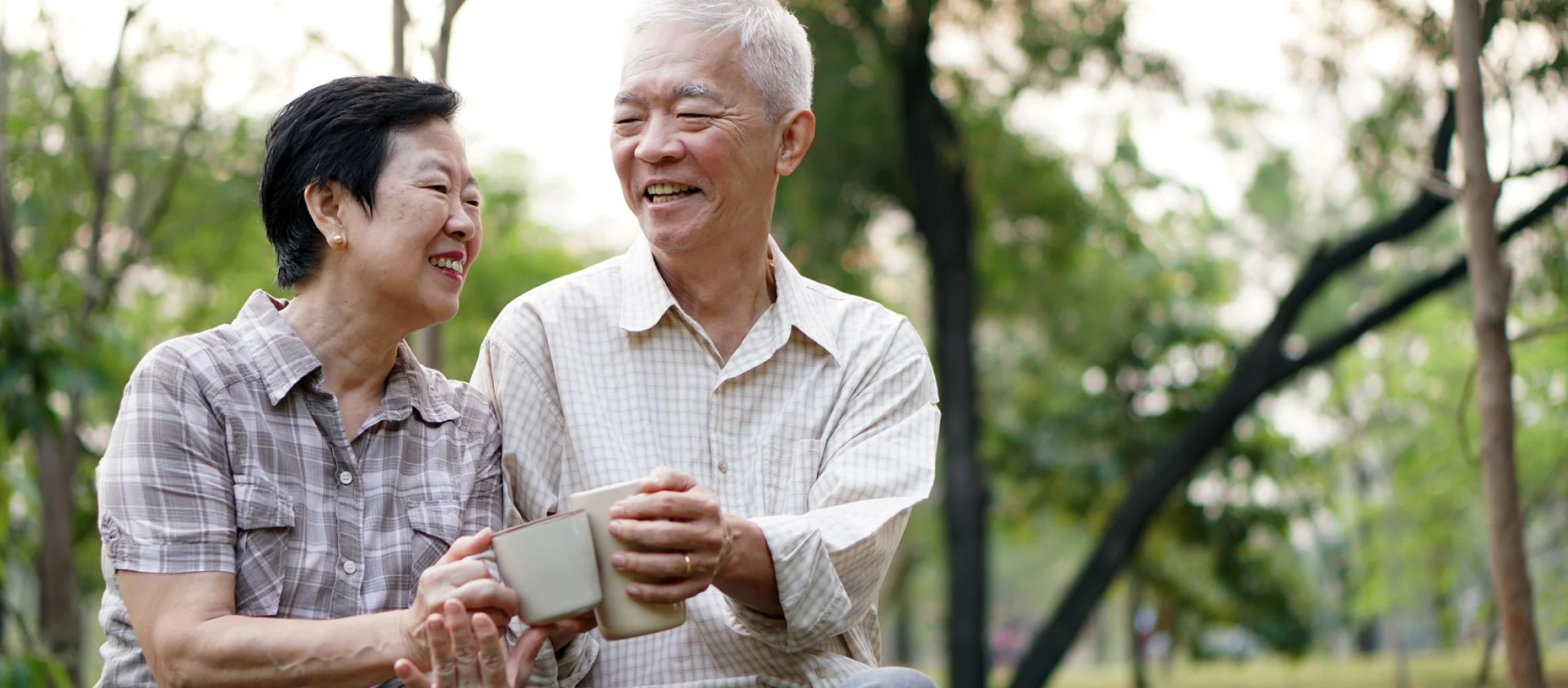
People living in more affluent areas can often live on average 10 years longer than individuals who live in the most deprived areas of the city.
People living in more affluent areas can often live on average 10 years longer than individuals who live in the most deprived areas of the city.
People living in more affluent areas can often live on average 10 years longer than individuals who live in the most deprived areas of the city.
People living in more affluent areas can often live on average 10 years longer than individuals who live in the most deprived areas of the city.
As a result, Active Leicester aims to Turn the Tide on Inactivity.
The strategy will predominantly focus on supporting the inactive and those most at risk of experiencing health inequalities to become more physically active. The strategy will follow the principles of proportionate universalism through embedding a population approach to inactivity with a focus on improved engagement with inactive communities, in partnership with stakeholders and communities themselves.
The strategy is for organisations, communities and individuals who have a willingness to work differently to initiate change and embrace collaboration with likeminded organisations to reduce silo working and support the most inactive residents
Small changes to ways of working can go a long way to tackling inactivity when combined with similar, likeminded organisations. Therefore, we would ask organisations to critically evaluate their practices and see what small changes can be made.
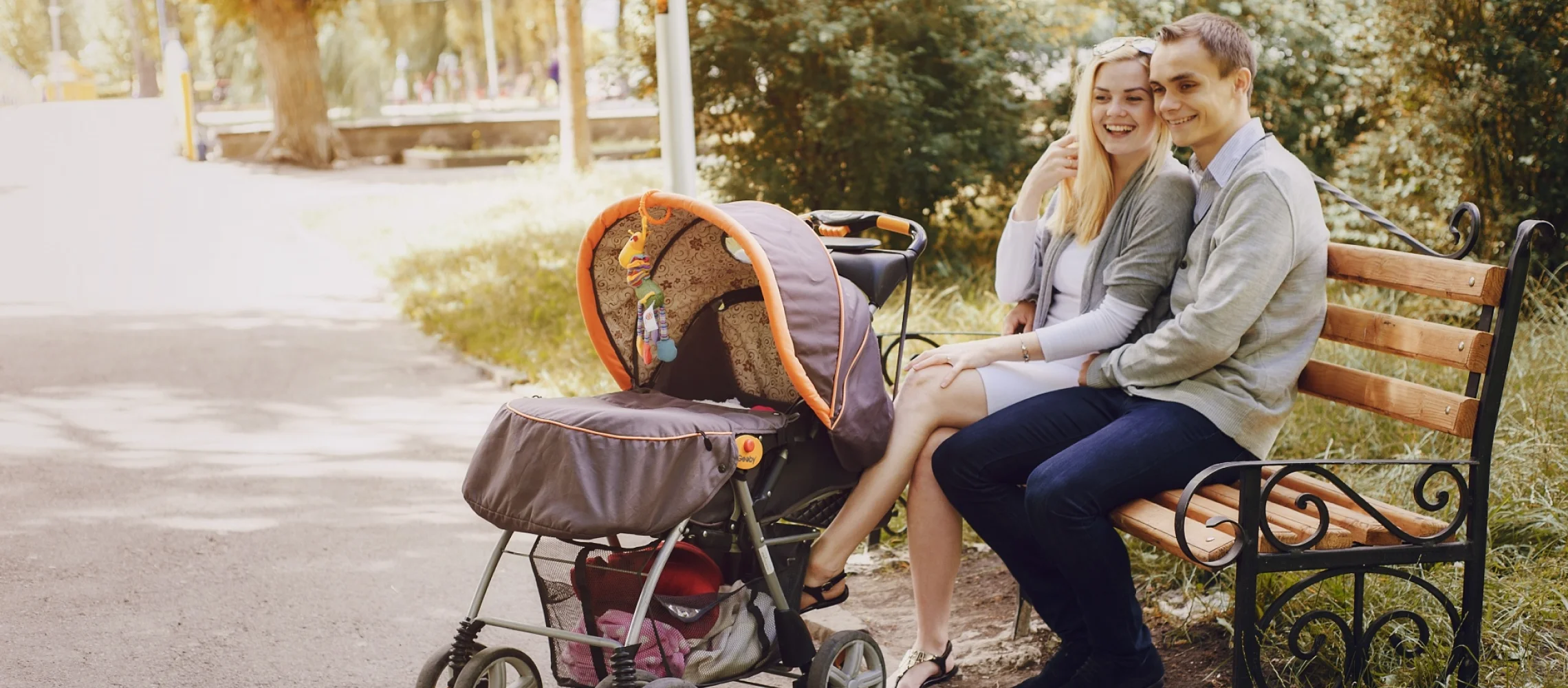
The key principles we would like organisations to adopt, as a way of working towards the strategy include:
1. To focus resource (full or part) on the city’s inactive population. Evidence suggests that these residents are more likely to be inactive in Leicester:
3. To focus on activity that is informal, local to where people live, which is recreational in nature, and an activity type that promotes participation with family and friends.
4. Engage, listen, support, and empower the local community. Utilising the role of community-based leaders and partners, whom have an in-depth knowledge of the community, and can support with the creation of sustainable activity models.
5. Create and engender collaborative working by partners, to deliver appropriate and tailored communications which facilitate long-term behaviour change, along with the sharing of resources, to where it is most needed, where inactivity exists.
6. Embrace and promote the use of personable technology to aid people to start, track and stay being active.
Active Leicester will target the inequalities of inactivity and support those in most need
We commit to continue to support and build on our universal offer, encouraging everyone to become more active but will focus predominately on our most disadvantaged geographic locations and on those groups more likely to be inactive. We will encourage long term behaviour change amongst the most inactive in our city throughout the life course but with particular emphasis on reducing inactivity amongst children and young people with a particular focus on girls, people from the most disadvantaged areas, some diverse communities, individuals with poor mental health and those with a physical or learning disability. The approach will include a focus on local, informal activity, the social element of being with friends, non-traditional activity, and a family centred approach to support the most inactive to engage in physical activity.
We will endeavour to make adopting long-term healthy lifestyle behaviours and positive physical activity choices the easy choice. We will focus on encouraging people to make small, sustainable changes to daily behaviours to improve longer term health outcomes.

We will do this through better collaboration, sharing of information and cohesive messaging and identifying key strategic partners, networks, and trusted community champions to create impactful partnership working. Our partners and residents are currently experiencing many challenges regarding the long-term impacts of COVID-19 and the more recent cost of living crisis, it is therefore vital that we work smarter, for greater effect. We aim to increase our engagement with organisations who have a willingness to work differently to encourage them to target their resource to those who are inactive. We will provide evidence, advice, and guidance on why tackling health inequalities should be a priority for partners and support them to target their services to those who are not only most at need but who will also most benefit from tailored, accessible, and local physical activity opportunities.
We are aware that there are many other local strategies that all have cross cutting themes with Active Leicester. We aim to ensure that this strategy complements and supports other relevant strategies rather than duplicating work. This strategy’s associated action plan will ensure that priorities align rather than duplicate the actions of other strategies or work programmes. This includes but is not limited to: Sport England’s Uniting the Nation, Active Together’s Physical Activity Framework, the city’s Health and Wellbeing Strategy, the Active Travel strategies on cycling and walking, and the role of Community Champions working from within and for communities. A list of interrelated strategies can be found in the appendices.
Active Start: Increasing physical activity for inactive children and young people
Active People: Increasing physical activity for inactive adults

Active Places: Development of place-based approaches to enable people to be active, in their own communities
Active Systems: Strengthen the systems necessary to implement effective and coordinated action to increase physical activity and reduce sedentary behaviour
Active Messaging: Improve long term behaviour change through improved communication
A 1% reduction each year in the 16+ population who are inactive = 10,000 people moving regularly for at least 30 minutes a week.
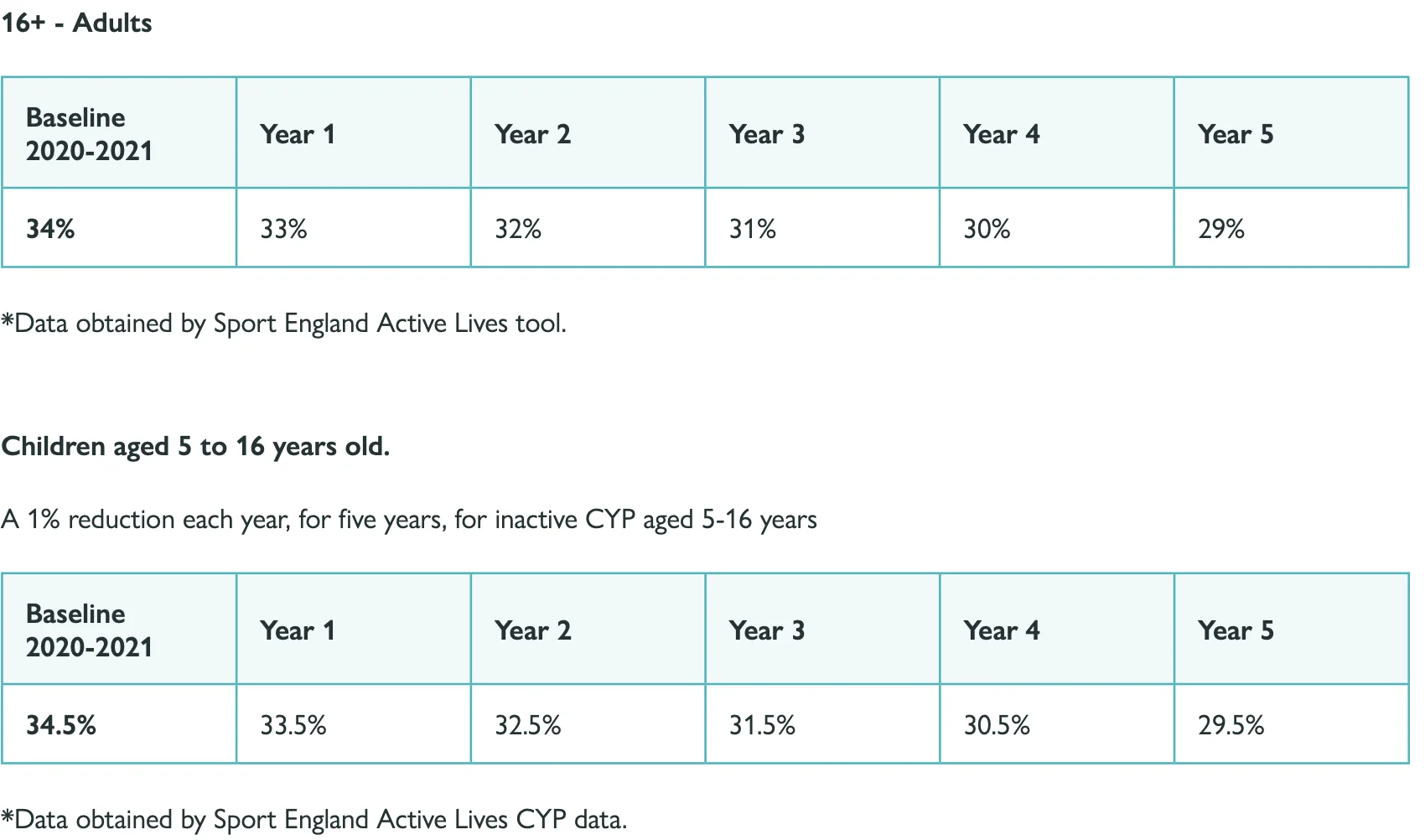
Sport and physical activity habits in the city is monitored and managed through variety of forums. The city’s Health and Wellbeing Board, Joint Strategic Needs Assessments (JSNAs) and Active Together’s ten-year sport and physical activity framework all exist to cement the importance of being physically active.Active Systems: Strengthen the systems necessary to implement effective and coordinated action to increase physical activity and reduce sedentary behaviour
Active Leicester’s ‘Turning the Tide on Inactivity’ shines a spotlight on the importance of being active, particularly for those residents, who would benefit the most. Therefore, Public Health and Sport Services at Leicester City Council will facilitate, monitor, and manage the creation of a new and live action plan that will be developed with likeminded organisations, whom have the willingness to work differently to initiate change. We will be asking organisations for a commitment to work with the council on this process.
The strategy will be formally measured and tracked by using the base line data from the annual Active Lives and other physical activity data sets.

Sport and physical activity habits in the city is monitored and managed through variety of forums. The city’s Health and Wellbeing Board, Joint Strategic Needs Assessments (JSNAs) and Active Together’s ten-year sport and physical activity framework all exist to cement the importance of being physically active.Active Systems: Strengthen the systems necessary to implement effective and coordinated action to increase physical activity and reduce sedentary behaviour
Regular physical activity provides a range of physical and mental health benefits, these include reducing the risk of disease, managing existing conditions and developing and maintaining good physical and mental function.
It can take many different forms; from moderate to high intensity exercise such as aerobics and running, muscle/bone strengthening such as weightlifting, balance training and to day-to-day activities like walking and cycling. The benefits of increased daily activity through walking, cycling and gardening for example can be effective in improving both physical and mental health and are often more manageable for the population to achieve during their daily lives.

Physical activity not only promotes good health and helps prevent and manage disease, it also contributes to a range of wider social benefits for individuals and communities. The importance of the wider benefits of physical activity for individuals vary according to life stage but can include improved learning and attainment, managing stress, improved sleep, the development of social skills and better social interaction.
Regular physical activity provides a range of physical and mental health benefits, these include reducing the risk of disease, managing existing conditions and developing and maintaining good physical and mental function.
Despite the highly publicised benefits of physical activity, most adults in the UK do not meet the minimum recommendations of doing 150 minutes (2 1/2 hours) of moderate intensity activity (such as brisk walking or cycling) or 75 minutes of vigorous intensity each week-1.
Nationally, nearly 3 in 10 adults do not meet this guideline. The 2020/21 Active Lives Survey shows higher rates of inactivity in Leicester compared to England. 36.8% of Leicester’s population aged 16+ did less than 30 minutes of physical activity per week and are therefore classed as physically inactive compared to 27.2% in England overall.
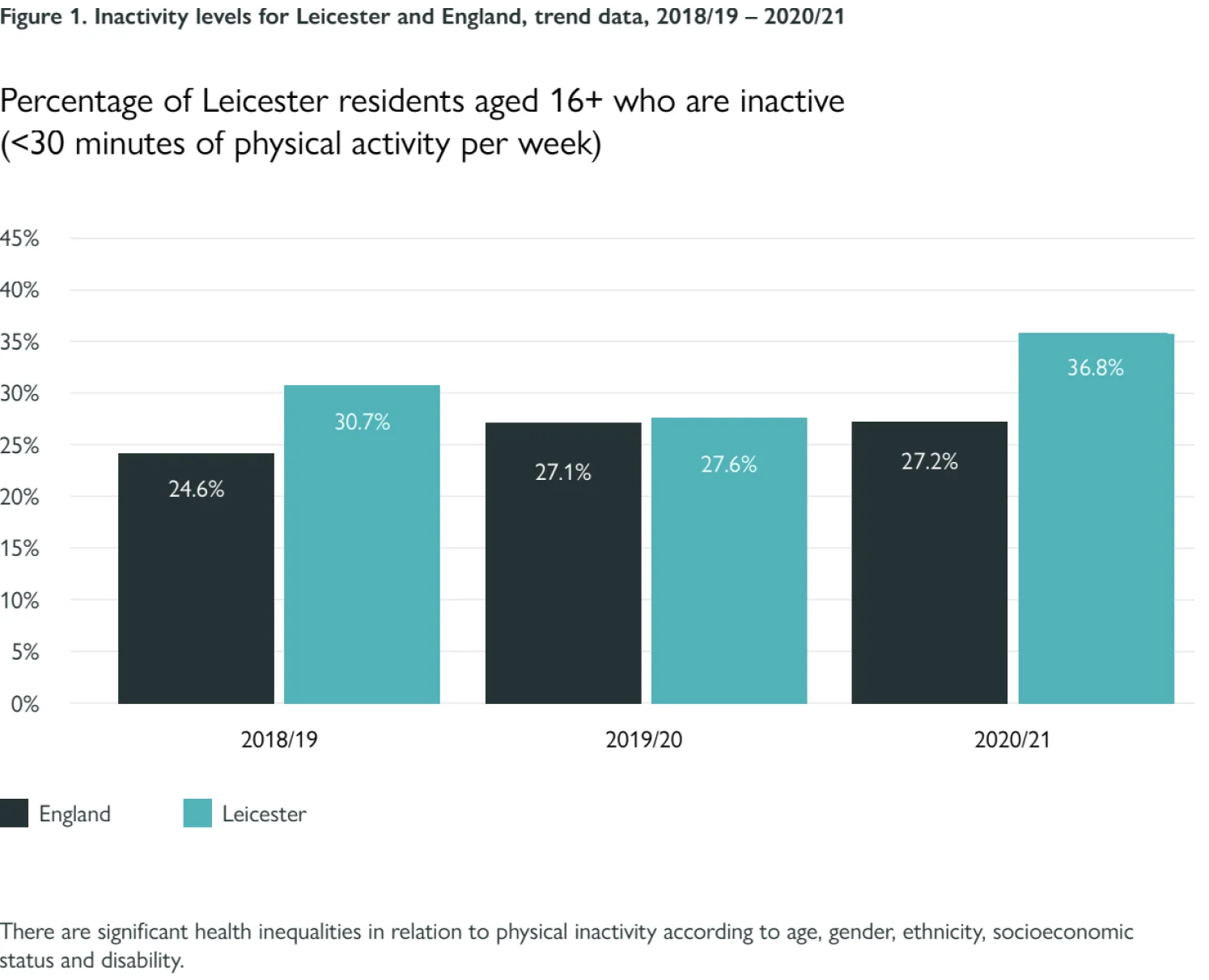
The figure below presents levels of inactivity (less than 30 minutes) across Leicester by ward, as per the Adults Health and Wellbeing Survey 2018. The map highlights that people in the east of the city are more likely to be physically inactive than those in the south and west.
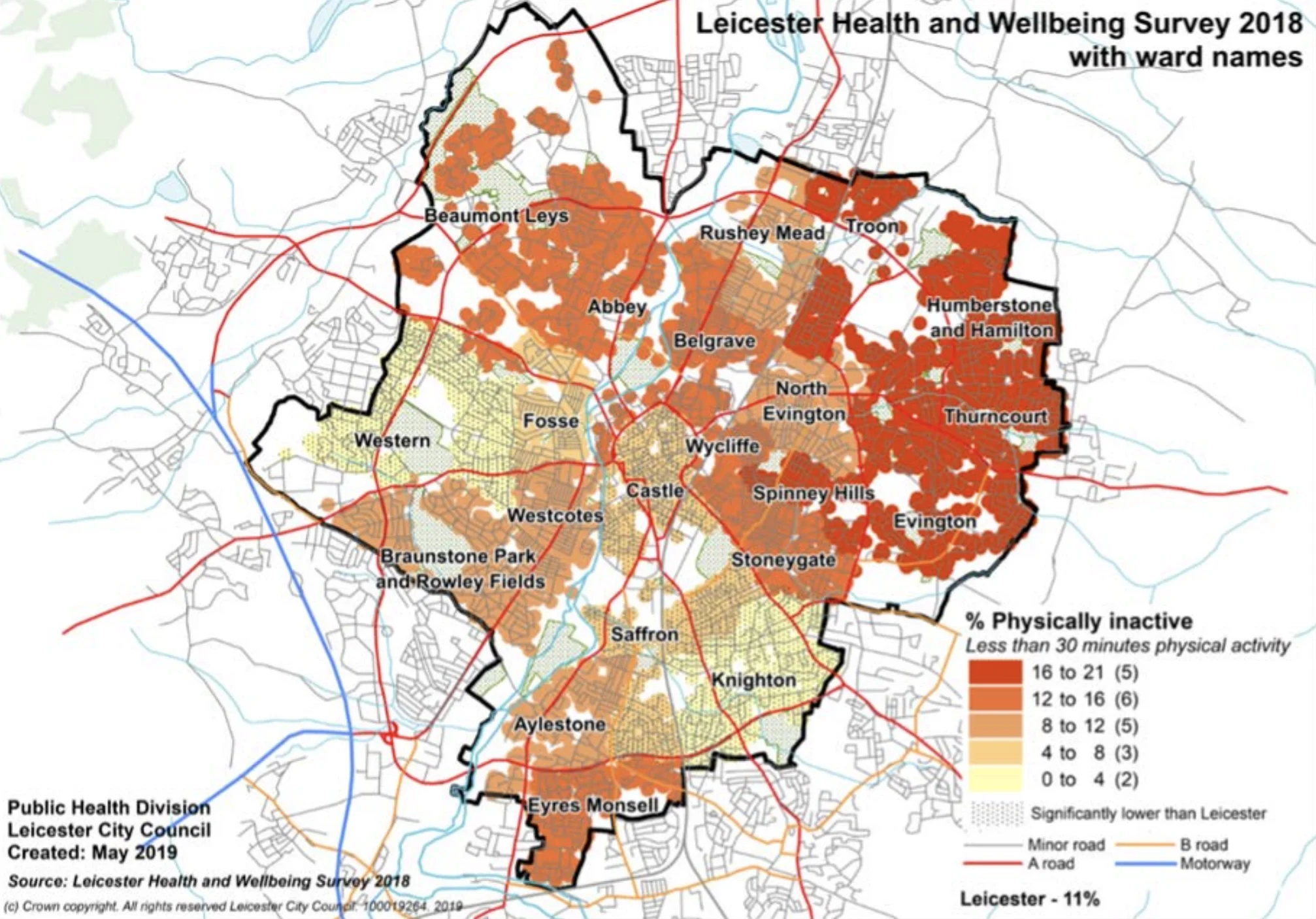

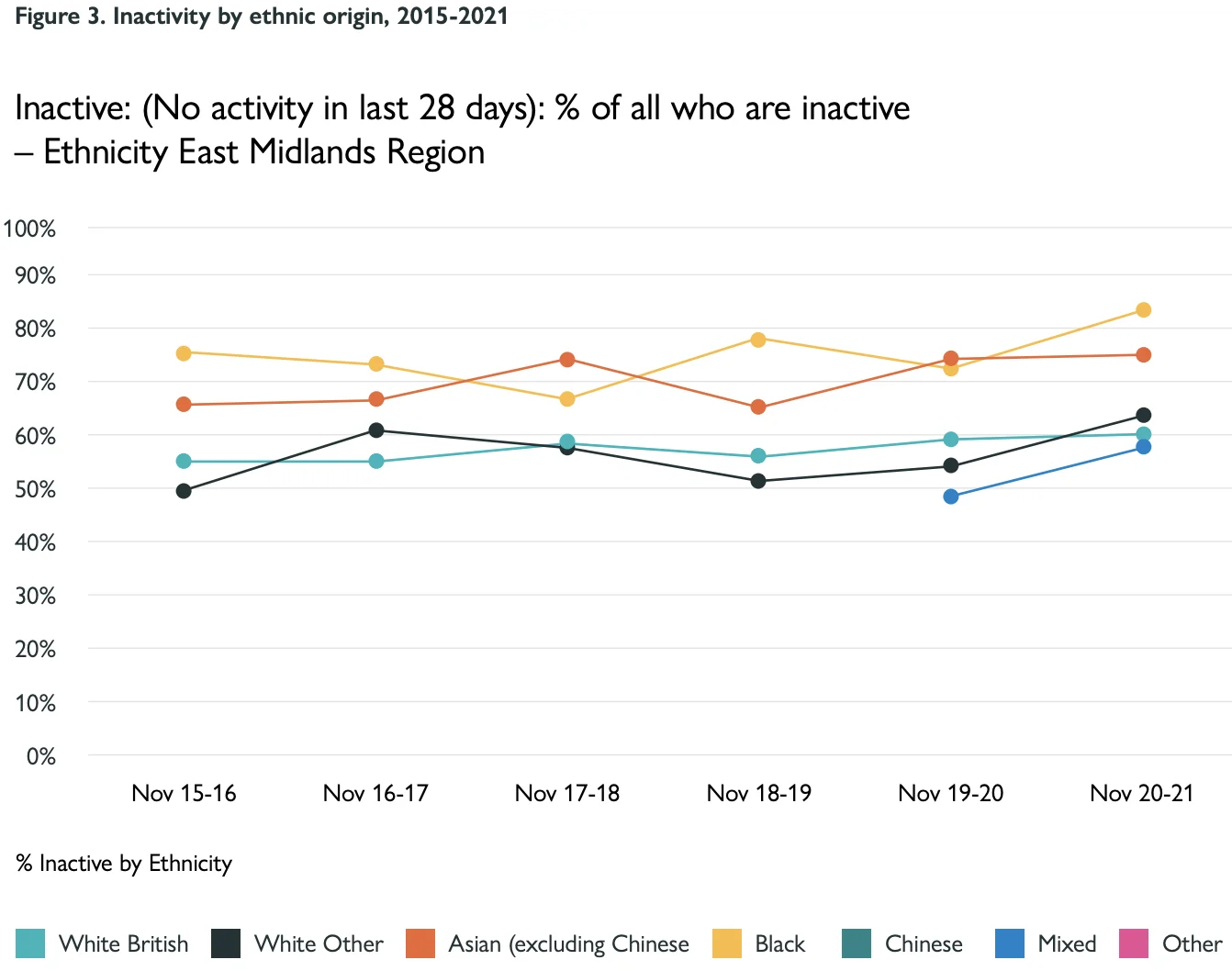
Studies tracking child obesity into adulthood have found that the probability of overweight and obese children becoming overweight or obese adults increases with age.
In an effort to monitor and mitigate this risk, the National Child Measurement Programme (NCMP) was introduced as an annually mandated programme to capture the body mass index (BMI) of children in Reception and Year 6 in state-maintained schools in England. The findings help inform local funding allocations and commissioning decisions through multiagency partnerships. In 2020/21, around 2 in 10 Reception-year children (21%) and 4 in 10 Year-6 children (41%) were classified as overweight and obese (combined) in Leicester. For children in Year-6, this is higher than the national average (38%). The latest NCMP figures are an increase on pre-pandemic years (2019/20).
Physical activity not only helps to reduce the risk of children and young people (CYP) becoming overweight and obese it is also associated with better physiological, psychological, and psychosocial health. Evidence shows that boys are more active than girls at all ages and that physical activity levels decline through childhood into adolescence. There is also some evidence to suggest that physical activity levels track from childhood into adulthood. As such, ensuring that all children are as active as possible throughout childhood is important for current and future population health.
Chief Medical Officer (CMO) guidelines for children and young people (5-18 years) state that they should engage in moderate to vigorous physical activity (MVPA) for an average of at least 60 minutes per day across the week. This can include all forms of activity such as physical education, active travel, after-school activities, play and sports. Children and young people should engage in a variety of types and intensities of physical activity across the week to develop movement skills, muscular fitness, and bone strength. Children and young people should aim to minimise the amount of time spent being sedentary, and when physically possible should break up long periods of not moving with at least light physical activity

The latest figures from Sport England, which are based on 1,233 responses to the Active Lives Children and Young People’s survey, show that for the 2020/21 academic year, 45% of Leicester’s Children and Young People aged 5-16 were physically active (60+ mins per day), 20% were active (30-59 mins per day) and 35% were inactive (less than 30 mins per day). 35% of CYP is equivalent to approximately 23,500 children, which highlights the scale of inactivity in the city.
Between 2017/18 and 2020/21, Leicester saw around a 5% overall increase in CYP who were active and a 4% increase in CYP who were fairly active, although both were not significant. More encouragingly, Leicester also saw an 8% reduction in CYP who were inactive which was significant. During the early stages of the pandemic, between 2018/19 and 2019/20, there were modest changes in CYP’s activity levels; those active decreased from 47% to 45% and those inactive increased from 29% to 31%. There has been very minimal change since 2019/20.
Whilst we do not have local data by ethnicity and deprivation, National estimates show variation in CYP activity levels by these two demographics. For the 2020/21 academic year, those of Asian (37%) and ‘Other’ ethnicity (33%) had the highest inactivity levels (<30 minutes per day), compared to Mixed (22%), White Other (24%) and White British (26%). When looking at deprivation, those most deprived showed over 10% higher levels of inactivity (41%) compared to those least deprived (30%); this was similar when looking at those active, with the most deprived reporting almost 10% less (38%) than those least deprived (46%).
Contributions to the higher rates of physical inactivity in Leicester include the high levels of deprivation we experience across the city. Barriers to being active amongst our residents include low income and affordability of exercise, access to facilities, cultural barriers, poor health, and community safety.
Despite ongoing efforts to bridge inequalities, high rates of physical inactivity are prevalent amongst females, people of Asian heritage, people of Black British ethnicity, people with a physical disability and low socioeconomic groups. Those in poor health, lacking formal qualifications, disabled, retired or with poor mental wellbeing were also significantly more likely to be physically inactive.
There is also geographical variation across the city, with the proportion of residents who meet the recommended amount of exercise differing; with residents in the west and south more likely to achieve the recommend amount of exercise, whereas residents in the east and north are doing less. This variation is likely to be related to both deprivation and ethnicity.
Leicester benefits from 130 parks, 13 of which are considered large parks, all offering something different for everyone. Facilities include playgrounds, outdoor gyms, park runs, walking and cycling trails and meditation areas. Leicester’s parks, open spaces, community gardens and riverside corridor provide opportunities to participate in organised sport and fitness sessions along with space to enjoy informal recreational physical activity opportunities. However, Leicester’s parks and open spaces are still not used effectively, Leicester residents are significantly less likely to exercise using outdoor space, with only 12% using parks or the countryside for health or exercise purposes compared to 17.9% in England, on a weekly basis. A priority of the Active Leicester Strategy will be to promote the use of free universal provision, particularly the use of the city’s wealth of parks and open spaces, as such a guiding principle of the strategy is the use of local, recreational spaces to be active in.

As people become busier, there has been more inclination to participate in informal activity. In Leicester’s Health and Wellbeing Survey (2018) informal activities were most popular with 47% of people walking for leisure and 35% walking for travel. A fifth of respondents named heavy housework (20%) and only a sixth (17%) referred to sports.
Active travel is identified as an increasingly popular form of physical activity, it is recognised that in Leicester two in five residents use some form of weekly active travel (either walking or cycling as a means of transport). Most people do not have access to a bike with only one fifth of residents reporting that they use a bike for travel. There are differences across the city when it comes to active travel; those in the west are more likely than those in other areas of the city to actively travel, whereas those residents living in the east are least likely to do so. This further highlights the importance of partnership work within this strategy particularly with planning and transport colleagues to increase the opportunity for people to become more active through increased access to bikes, opening of walkways, lighting, and community safety measures for example. At present only 26% of the population utilise designated sport and leisure facilities to exercise. Whilst we are aware that not everyone will use a designated sports and leisure facility this does tell us that we do have the capacity and scope for our facilities to play a larger role. Formal activity also remains underutilised. A quarter (26%) use sports and leisure centres at least once a month, but almost half (48%) never use them; 13% use outdoor gyms at least once a month, with two thirds (67%) never using them. One in ten (10%) Leicester residents’ cycle along a cycle route at least once a week.
Over the last 2 years, there has been a significant impact from the COVID-19 pandemic. The virus has posed serious challenges to the residents of Leicester with the city experiencing an extended lockdown which severely limited the opportunity for people to remain active. Requirements for self-isolation particularly amongst the clinically vulnerable and the emergence of newer variants posing need for harsher and ongoing restrictions further impeded the return of employees to physical workspaces. This not only reduced the positive mental benefits of social engagement in the workplace but also physical activity from commuting to work and in the work environment. As a result of the pandemic many food businesses increased their delivery and take away options, resulting in larger numbers accessing more unhealthy food whilst also becoming less physically active. This increasing consumption of out-of-home meals has been an important contributing factor in the increasing rates of obesity, with higher rates noticed in the unemployed, sick/disabled, specific ethnic groups and those between ages 16 and 34.
The 2020/21 cohort for National Child Measurement Programme (NCMP) data collection is much smaller due to issues with data collection during the pandemic, which may affect the quality of the data presented, however the data did show fairly drastic increases in unhealthy weight amongst reception and year 6 children in Leicester during the pandemic. NCMP data for 2021-2022 shows that unhealthy weight levels in CYP across the city are improving, however it has not reduced to pre-covid levels.

Leicester is keen to continue to promote and develop its universal offer of physical activity to all residents across the city.
Multiple opportunities for people to become physically active will result in multiple benefits not only to the physical and mental health of our residents but to employment, community development, tourism, and infrastructure amongst others.
To support people to become more physically active we already have many opportunities for activity to be integrated into daily lives, work and play and this will remain a priority going forward. Increasing physical activity across the life course is a key aim of Active Leicester, encouraging active play and recreation in early childhood will support healthy growth and development, improve school readiness, family inclusion and physical literacy for long-lasting, healthy lifestyles.
Active Leicester also provides an opportunity to further develop digital innovations to support people and families of all ages to be more active in a manageable and effective way. The Active Leicester website continues to be improved along with the development of a phone app that will enable easier access to leisure centre information such as class and swim timetables but also self-help tools.
Leicester has many assets to encourage and support greater participation in physical activity, from leisure centres and sports clubs to numerous parks and outdoor gyms which can be used for free. The wide range of provision across the city aims to ensure that both formal and informal activity is accessible to all our residents.
The map on the following page highlights Leicester’s outdoor gyms, sport and leisure centres, and public green spaces:
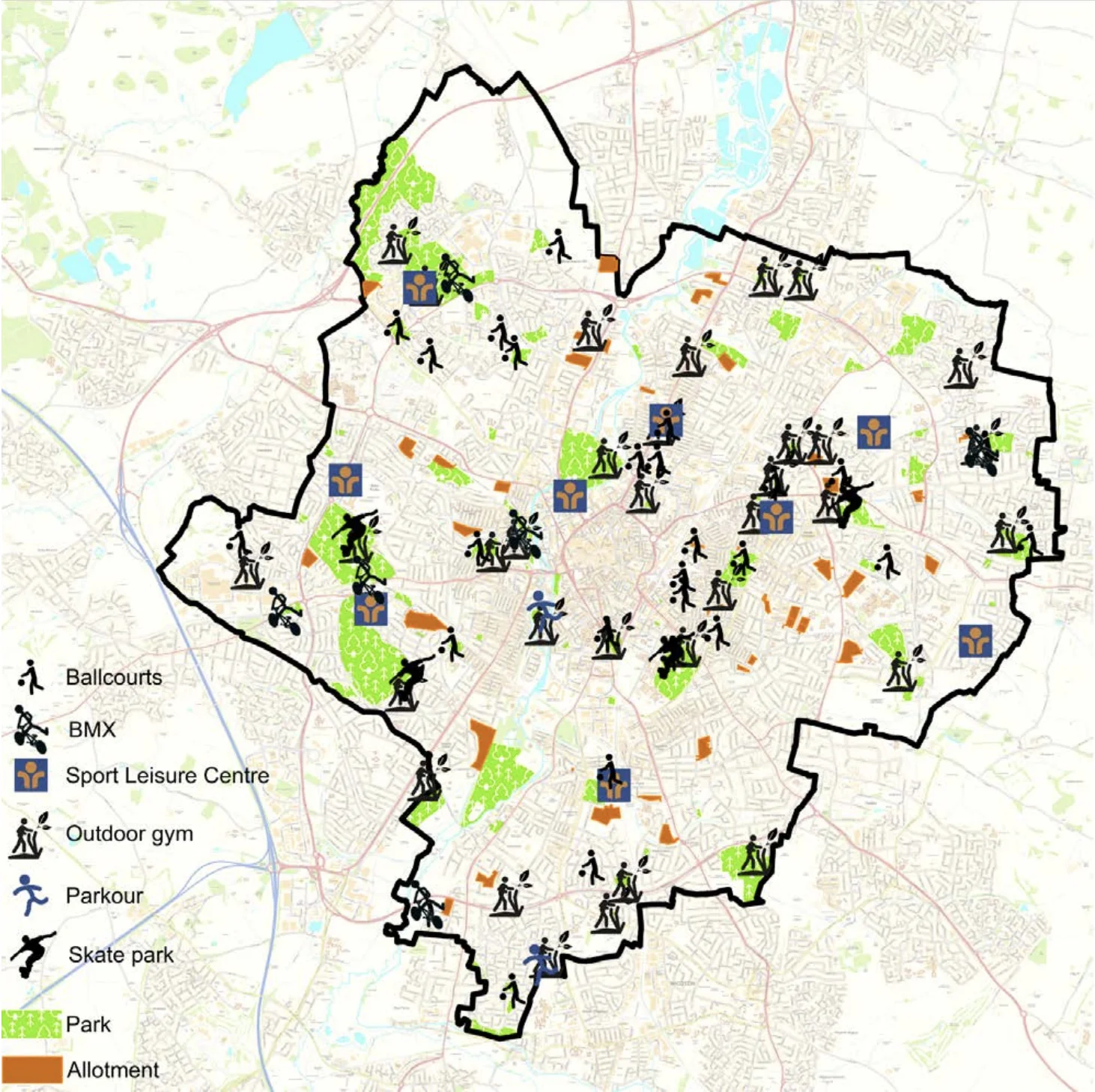
The types of universal provision available in the city include, but are not limited to, sport and leisure facilities across the city providing a variety of opportunities for participation in indoor activities such as swimming, badminton, table tennis and climbing. Outdoor opportunities include golf courses, football pitches, athletics tracks, outdoor gyms, park runs, walking and cycling.
The city benefits from five successful professional sports clubs all of which provide opportunities for people to become physically active through their community outreach programmes. In addition, the Live Well Leicester lifestyle service is available to support clients into a wide variety of lifestyle support including exercise, weight management and smoking.
Opportunities for people to participate in informal activity such as gardening are also available across the city and more structured activity through a vibrant private and self-employed sector of gyms, community-based sessions, and freelance instructors.
Despite the universal offer of physical activity and sport in Leicester we still see lower levels of physical activity, particularly amongst the most deprived with further variations depending on people’s gender, ethnicity, age, and disability. As previously discussed, people who are less active are often pre-disposed to experience poorer health outcomes, life limiting disability, multiple co-morbidities, and lower life expectancy. Leicester experiences vast health inequalities and we continue to see this gap increasing, particularly accelerated by the COVID-19 pandemic.
The strategy development included a wide ranging and in-depth consultation with key partners and community members from a variety of sectors including the voluntary sector, charities, statutory organisations, health professionals, the education sector, and professional sports clubs. Also consulted were groups representing the very young, preschool children, schools, colleges and universities and groups representing and working with the elderly

Tackling health inequalities was a priority for most stakeholders, whilst they supported a continuation of encouraging everyone to be active, they felt groups, ethnicities, areas and communities across the city needed additional support with targeted, accessible options for those that are most at risk of experiencing poor outcomes as a result of being inactive. In addition, an appetite for wider systems thinking was apparent from stakeholders who identified that working in silo will not have the impact this strategy strives for when supporting the marginalised to be more active. They noted that a systems approach will not only benefit the individual and community, but additional benefits will be seen across many other sectors including community safety, health and social care and education.
Tackling health inequalities was a priority for most stakeholders, whilst they supported a continuation of encouraging everyone to be active, they felt groups, ethnicities, areas and communities across the city needed additional support with targeted, accessible options for those that are most at risk of experiencing poor outcomes as a result of being inactive. In addition, an appetite for wider systems thinking was apparent from stakeholders who identified that working in silo will not have the impact this strategy strives for when supporting the marginalised to be more active. They noted that a systems approach will not only benefit the individual and community, but additional benefits will be seen across many other sectors including community safety, health and social care and education.
Stakeholders felt that prioritising informal and everyday activities should remain a priority in supporting marginalised individuals and diverse communities to become more active along with family centred approaches.
Reference list of supporting strategies and information
Tackling health inequalities was a priority for most stakeholders, whilst they supported a continuation of encouraging everyone to be active, they felt groups, ethnicities, areas and communities across the city needed additional support with targeted, accessible options for those that are most at risk of experiencing poor outcomes as a result of being inactive. In addition, an appetite for wider systems thinking was apparent from stakeholders who identified that working in silo will not have the impact this strategy strives for when supporting the marginalised to be more active. They noted that a systems approach will not only benefit the individual and community, but additional benefits will be seen across many other sectors including community safety, health and social care and education.
Send us a email to quoting ‘Gymnastics’ in the subject line.
Company
Quick Links
More